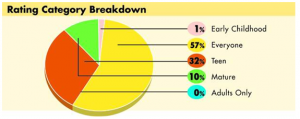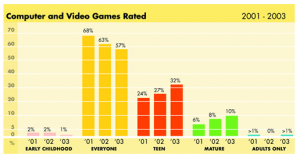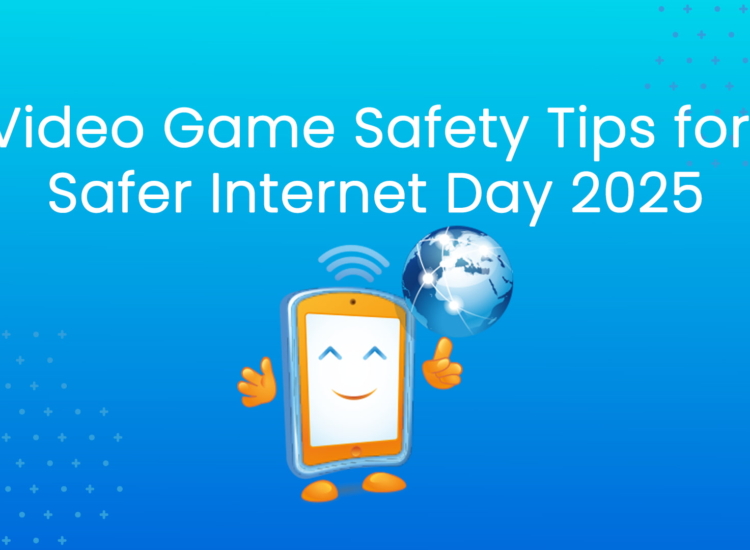Congressional Senate Testimony From ESRB President Patricia Vance
Written Testimony of Patricia Vance
President
Entertainment Software Rating Board (ESRB)
September 28, 2004
2:30 PM
U.S. Senate Committee on Commerce, Science, and Transportation
Subcommittee on Science, Technology, and Space
Hearing on the Effectiveness of Media Ratings
Mr. Chairman, I appreciate the opportunity to appear today to present an overview of the ESRB rating system and more broadly discuss the critically important issues surrounding the most effective ways to inform consumers, especially parents, about the content of the entertainment their families consume.
Background
The ESRB has been in existence for ten years. It was created in 1994 with one central mission: to provide parents and consumers at large with the information they need to make informed computer and video game purchase decisions. Today, we remain extremely proud of the ESRB rating system and the information it provides to parents. Indeed, the Federal Trade Commission and leading policymakers have praised it for its effectiveness and comprehensiveness. The rating system, although voluntary, has been universally adopted by the industry and today virtually all computer and video games sold in the U.S. carry an ESRB rating. In fact, most retailers in the U.S. refuse to stock games that do not carry an ESRB rating.
After consulting a wide range of child development and academic experts, analyzing other rating systems, and conducting nationwide research, the founders of the ESRB concluded what parents really wanted from a video game rating system were both age-based categories and, equally if not more importantly, objective and detailed information about what’s in the game. Parents surveyed agreed that a rating system should inform and suggest, not prohibit. Respondents also agreed that the rating system should not attempt to quantify objectionable incidents; instead it should reflect the overall content and objective of the game.
The ESRB Rating System
Based on the research conducted in 1994, the ESRB rating system was created with two equally important parts: 1) easily identifiable rating symbols, found on the front of game packaging, suggesting the most appropriate age group for each game, and 2) content descriptors, found on the back of game packaging, clearly stating why a game received a particular rating or indicating content that may be of interest or concern.
Here’s an illustration of the two parts:
The five ESRB rating categories include:
- EC – Early Childhood means the game may be suitable for ages 3 and older, and is specifically designed for young children.
- E – Everyone means the game may be suitable for ages 6 and older. E – rated games may contain minimal cartoon-like violence or comic mischief, and are generally appropriate for a wide range of audiences.
- T – Teen means that the content may be suitable for ages 13 and older, and may contain violence, limited amounts of strong language, or suggestive themes.
- M – Mature means that content may be suitable for ages 17 and older and may contain sexual themes, intense violence, or strong language.
- AO – Adults Only means that the product is intended only for ages 18 and over.
Over 30 different content descriptors are currently in use. They span various categories of concern to parents, including but not limited to violence, language, suggestive or sexual content, and use of controlled substances
As a point of reference, of the 1,176 games rated by the ESRB in 2003, 57% were rated E – Everyone and 32% were rated T – Teen. Games rated M – Mature represented 10% of games rated, with EC – Early Childhood representing most of the remaining 1%.
Ratings Creep?
Comparing the above data to prior years shows that the E for Everyone category has been declining slightly each year, while the Teen and Mature categories has been gradually increasing. It’s not surprising that there are more Teen and Mature games because over the last decade the core audience for games has steadily aged. In fact, today, the core audience is 18-35 years old and the average age of game players is now 29 years old. Thus, it is perfectly logical to see game publishers create more titles aimed at this older consumer.
This upward shift in ratings assigned would refute assumptions that some critics have made about “ratings creep” in our system, since evidence of “ratings creep” would suggest that lower categories are getting larger, not smaller. But, just to be sure, as a test, we recently selected ten top-selling Teen and Mature-rated games from five years ago and ran them through our standard rating process to determine if they would receive the same ratings today. Raters had no idea they were evaluating 5-year old game titles. The results of the test were that all ten games received the same ratings they had originally received.
Recent Improvements
As we have done periodically since establishing the ESRB ratings system, last year, the ESRB took several pro-active steps to further ensure that consumers are getting the most out of the rating system. One step was to add several new content descriptors to provide greater nuance in several categories. Four new descriptors in the violence category alone were added to the system. A second pro-active step taken was to increase the visibility of the content descriptors on the back of every game box. This was achieved by repeating the rating symbol on the back of the box next to the content descriptors in an authoritative “seal”. All games shipped to stores in the last year carry this new “seal”. And the third step the ESRB took to increase the effectiveness of the rating system was to add the age “17+” to the M – Mature rating symbol and 18+ to the AO – Adult Only rating symbol, so consumers more clearly understand the specific age range we are suggesting.
Senator Joe Lieberman, who has worked closely with Chairman Brownback on issues related to media violence and monitoring the video game industry’s ratings and marketing practices, remarked of these enhancements, “I appreciate the ESRB’s ongoing commitment to helping parents make smart choices for their kids. I hope parents will return the favor by making better use of these better ratings, for in the end they have the primary responsibility to protect their kids ….”
Rating Process
So, what is the process for assigning ratings? In order to have a game certified with an ESRB rating, software publishers fill out a detailed questionnaire explaining exactly what’s in the game. This questionnaire is submitted to ESRB along with actual videotaped footage of the game and relevant supplementary materials (e.g. soundtracks, cheat codes, scripts). The video footage must not only accurately represent the final product as a whole, but it must also show the most extreme content of the game. In the event that the ESRB discovers undisclosed pertinent content that would have affected a rating after a product has shipped, enforcement measures can be taken, including the imposition of significant fines and corrective actions (e.g., re-stickering or recalling product).
Once the submission is received and checked for completeness, a minimum of three raters independently view video footage of each game and, for every scene, as well as the overall product, recommend a rating and content descriptors they deem most appropriate. ESRB compares the raters’ recommendations to make sure there is consensus. Usually, the raters agree on an overall age rating and their recommendation becomes final. However, when the raters recommend different ratings, additional raters will review the game in order to reach consensus. Once consensus on a rating is reached, ESRB issues an official rating certificate to the game’s publisher. If a publisher is not satisfied with the rating issued, it may re-submit the game with changes and the process starts anew.
In rating a game, raters must consider a wide range of content elements including but not limited to violence, sex, humor, language, and use of controlled substances. There are few hard and fast rules when it comes to rating games. The manner in which a particular act is depicted, the context in which it occurs, the intensity of the image itself, and the degree of player control (unique to our rating system) all can greatly affect which rating category and content descriptor(s) ultimately are assigned to the game. Some have suggested that game ratings be based on a numerical count of particular types of content, such as acts of violence. I cannot say if this would work in other media. But trying to quantify content in an interactive medium when players control the frequency of actions and the events themselves is particularly impractical and pointless. Those who have played or studied video games universally recognize that the element of player control makes the medium and consequently its rating system unique.
It is critical to note that ESRB raters have no ties to the industry and are specially trained by us to rate computer and video games. Most ESRB raters have prior experience with children, either as parents, caretakers, or through prior work and education. They are part-time employees of the ESRB, and typically attend one rater session per week. The ESRB strives to recruit raters who are demographically diverse by age (must be over 21), martial status, sex, race, and cultural background to reflect the US population overall.
Research
In order to ensure that the ratings we assign reflect the standards of average American consumers, we conduct consumer research on an annual basis in ten different markets across the U.S. This research has consistently shown that parents overwhelmingly agree with the ratings that we apply. Peter D. Hart Research Associates, a nationally renowned independent opinion research firm, tests randomly selected video games rated during the prior 12 months with parents of children between the ages of 6 and 17. We show parents clips of actual game footage and ask what rating they would apply. Then, we compare their responses to the actual rating assigned by the ESRB.
Last year this research found that parents agreed, or even thought our ratings were too strict, 84% of the time. Parents described the actual ratings as “about right” in 77% of all instances and “too strict” 7% of the time. Ratings issued by watchdog groups like The National Institute on Media and the Family, with whom Chairman Brownback has worked closely over the years, also confirm that ESRB ratings are reliable and, in fact, NIMF’s own ratings agree with ESRB an overwhelming portion of the time. We think that’s pretty good. And we recognize that in a pluralistic society like ours, which encourages and embraces differences among its citizens, no rating system could ever achieve 100% popular consensus. However, it is clear that ESRB ratings are well within the American mainstream, and that’s exactly where we want to be.
Other opinion polls conducted by Hart Research show that parents not only agree with specific ESRB ratings, but that 90 percent of them say the ESRB rating system provides the kind of information they need. Moreover, approximately 75 percent say it’s an effective tool that helps parents shield their children from inappropriate game content.
Supporting the Hart research is a new survey released by the Henry J. Kaiser Family Foundation last week, which found that among all entertainment rating systems (TV, movies, music, and games), parents found the ESRB ratings to be the most useful, with 91% finding them “somewhat” (38%) to “very useful” (53%).
Of course, some have expressed concern about some aspects of the ESRB system. We respect these concerns and have worked hard to maintain a dialogue with any and all persons who care about giving parents accurate ratings information. Like anything else, though, it is important for observers to look beyond the headlines and carefully examine the methodologies of those who have issued studies critical of the ESRB or other systems. For example, the headline of the Harvard press release earlier this year publicizing Professor Kimberly Thompson’s study of Teen games reads, “Ratings of Teen-rated video games do not always fully describe content.” Sounds pretty ominous. But in truth, Professor Thompson concluded that 95% of instances of violence found in games included in the study were properly labeled by the ESRB. In other words, in the category of greatest concern among parents, ESRB content descriptors were applied to virtually all of the 81 games included in the study.
The Harvard study also suggested that ESRB was not issuing content descriptors labeling other relevant content. For example, the study stated that a game depicting a character holding a non-lit pipe – not smoking it – should have a “Use of Tobacco” content descriptor. Here we have an honest disagreement about rating theory and standards. ESRB raters would not have applied a “Use of Tobacco” descriptor in this case because the content was not significant from a contextual standpoint, and characters were not actually smoking. Similarly, unlike the Harvard researchers, we would not apply a “Reference to Alcohol” descriptor if a couple of unmarked bottles appear on a table in a scene. Our consumer research leads us to conclude that neither would most parents. All this said, I have great regard for Professor Thompson and I believe she is committed to helping us enhance the ESRB rating system and we welcome a continuing dialogue with her and others.
Universal Ratings
The Subcommittee asked that I comment on the issue of universal ratings. Candidly, I have serious concerns about this idea, though I understand its appeal. In the case of video game ratings, I think it is clear that our system is well received and considered effective and easily understood by consumers. Moreover, there is little evidence that consumers are confused by the current media rating systems. What is confusing about a game with a Mature 17+ rating with an Intense Violence content descriptor? It is not complicated or difficult for a consumer today to understand what type of video game they are purchasing. At a minimum, by picking up a box, checking the ratings information and looking at the title, images, screen shots and descriptions right on the packaging, it’s hard to imagine a consumer would not know what he or she is getting. And a recent study by the Henry J. Kaiser Family Foundation confirms that nearly six out of ten parents surveyed think a single rating system is unnecessary.
I would also be concerned about whether it is even practical to develop a coherent single rating system that actually does simplify information for consumers. All media are not the same. Motion pictures and television programs usually involve visual depictions of real actors on film in realistic situations; music consists of auditory and occasionally visual elements. Music, film, and TV are passive media. But games are interactive. This element of player control makes games unique among entertainment media and it is not at all clear to me that one could devise a single system that could accurately or effectively capture the different aspects of various entertainment media.
Raising Consumer Awareness
Hopefully, by now you have a better understanding of the ESRB rating system, how it was developed, how we apply ratings, and what consumers think about those ratings. Now, I want to direct your attention to the extensive efforts we are making to raise consumer awareness and use of the rating system.
First, it’s important to define who the “consumer” is. According to a study conducted by the Federal Trade Commission in September 2000, parents are involved in the purchase or rental of games 83% of the time. The ESA has found in similar research that adults make 90% all game purchases. Regardless of the data source used, it is clear that, parents are either involved in or ultimately making the decision about what games their kids are playing an overwhelming majority of the time.
Keeping in mind the significant role parents play in making purchase decisions, the ESRB launched a multi-channel consumer marketing campaign in October 2003 featuring the slogan “Ok To Play? – Check The Ratings”. The campaign, composed of a public service announcement (PSA) and a retail partnership program, encourages parents to use both components of the rating system (rating symbols and content descriptors) to determine if a game is appropriate for their family.
During the first six months of the campaign’s launch, the print PSA campaign (see attached ad) generated more than 500 million gross consumer impressions. 5 of the top 10 consumer magazines including TV Guide, Better Homes and Gardens, Good Housekeeping, Family Circle, and Ladies’ Home Journal, plus Entertainment Weekly, Redbook, Parents, Working Mother, and Disney Adventures have run the print PSA. More than a dozen top game enthusiast publications have also supported the campaign, and over 20 websites have run an online banner version of the ad. Furthermore, several major national retailers (e.g., Wal-Mart, Toys R Us, EB Games) have included a “ratings legend” that ties into the campaign in their print circulars and catalogues.
The second critical part of our consumer awareness campaign is the launch of a unique retail partnership program. The goal of the program was to ensure that when consumers were shopping for computer and video games that they would be educated about and reminded to check the ratings. But rather than send posters or stand-alone brochures to stores that consumers may not notice, we succeeded in getting 12 of the top 14 retailers of games in the US, representing over 85% of all sales, to incorporate ratings education into their in-store display fixtures. All participating retailers, including Wal-Mart, Best Buy and Toys R Us to mention some of the largest, have re-printed and installed new signs for their game displays this year. ESRB has also provided these retailers with training materials for sales associates to learn about the rating system, and signage supporting store policies restricting the sale of Mature rated games (see attached store sign composite).
Since launching the retail partnership program, the ESRB has conducted audits measuring compliance from retailers in displaying “Ok To Play? – Check The Ratings” and store policy signage. The most recent information from last month, which surveyed more than 4,100 store locations from six chains, indicated that 62% of stores were displaying their signs.
Recently, the ESRB expanded the retail partnership program to include local independent retailers and cyber café businesses, working closely with the Video Software Dealers Association (VSDA) and iGames to help penetrate these hard-to-reach outlets.
We encourage the Chairman, Subcommittee members and Congress to support these efforts to further raise consumer awareness and use of the rating system.
Other ESRB Activities
On a final note, ESRB work does not begin and end at ratings. In addition to the Rating Board, the ESRB is responsible for the oversight, compliance, and enforcement of industry-adopted advertising and marketing guidelines. This is performed through the Advertising Review Council (ARC) of the ESRB, which publishes the industry’s Principles and Guidelines for Responsible Advertising Practices defining standards for responsible advertising practices, and providing information on enforcement, complaint resolution, appeals, and compliance. Additionally, specific marketing rules are codified in the ESRB Advertising Code of Conduct, addressing everything from the required size of rating icons on game boxes to the audience composition of media vehicles in which M – Mature rated ads may appear. All publishers of games certified with an ESRB rating are legally bound to these marketing guidelines.
The ESRB diligently monitors compliance with guidelines and in the event that a game publisher inappropriately labels or advertises a product; the ESRB is empowered to compel corrective actions and impose a wide range of sanctions, including monetary fines where appropriate.
In 1999, the ESRB launched the Privacy Online division in order to assist industry companies in the development and ongoing management of the online collection and use of personal information. The FTC endorsed the Privacy Online program as a “safe harbor” under the Children’s Online Privacy Protection Act (COPPA). The division services companies in the development of privacy policies, ongoing monitoring and enforcement of stated practices, privacy complaint filtering and processing, employee training, and continuing consultation.
Closing Statement
I hope this testimony provides a clearer and broader understanding of the ESRB than when you arrived today. Thank you for inviting me here today and I’m grateful to have the opportunity to explain what we do and how we do it. We take great pride in our work and the service we provide to parents and other consumers of computer and video games. I look forward to having a constructive dialogue with members of the committee and answering any questions that you may have.
Thank you.





